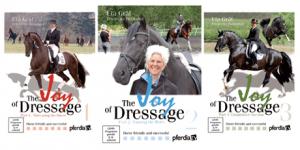By Peggy Gaboury
A couple of years ago I went to a Judge’s Viewpoint seminar in Austin, Texas, presented by Christoph Hess. Hess is an international judge, and the Head of the Education Department of the German Equestrian Federation.
He opened the seminar by playing a video clip of Uta Gräf on then six-year-old stallion Damon Jerome. We were instructed to use this rider and this horse as our standard of reference in evaluating all of the other video clips of horses and riders that would be used in the seminar. He played the video about five more times over the course of the two days. I went home with a firm picture in my mind of this superbly quiet rider on a hugely moving, fluid, and dynamic horse. Her legs never moved unnecessarily; she occasionally flicked a rein forward and returned her hand to a completely steady contact. The horse waited for her seat and was always responsive. He was the perfect of image of willing and relaxed cooperation!
When I got home I searched the Internet, but didn’t find much in the way of good quality video of Uta and Damon Jerome. I found a couple of YouTube clips, but they had been shot at shows from angles that limited what one could see. Last year, Uta Gräf premiered a 3 DVD set, so I saved my pennies and finally got it this winter.
Uta Gräf’s agenda is apparent throughout the series. She wants horses, even high level, very expensive horses, to live natural lives, with lots of turn-out in big pastures. She wants training to be built around the needs of the horse, with respect at all times for how the horse learns. She wants people to be riding horses that they can, in fact, ride. If the rider is overwhelmed by the gait of the horse, the end result will be a fearful rider who over-controls the horse and communicates tension. In her ideal world, the rider would never be thinking, “Oh, I need to be careful here; I need to ride in a controlled way.” Rather, the rider should be thinking in a way that encourages the horse to use his body as the rider wishes, with suggestion and reward, not constraint.
The videos in the series consistently demonstrate both her goals and her ability to achieve those goals. The horses show willing and relaxed work, from the horse just starting out with walk, trot and canter, to the horses working Intermediaire and Grand Prix movements.
The first DVD shows, primarily, examples of warm-up work. There is a good deal of footage of Damon Jerome, both at home and from the Judge’s training clinic, from which the video we saw in Austin was generated. There is also footage of Ute riding a very green horse who is just learning to reach for the bit, and her Grand Prix horse. She talks about the differences in the warm-ups that these different horses require. These differences are based both on level of training and differences in the personalities of the horses.
The second DVD shows training sessions at home. Included are clips of Ute working alone, of her teaching students at various levels of ability, and of herself in lessons with her own trainer. At all times, her emphasis is on creating a relationship with the horse that allows for “expression through calmness and not through tension.” She reiterates, often, that a good movement should be rewarded by relaxation. For her, lightening the seat into a forward position, while allowing the horse to enjoy a full stretch of the back and neck, is generally the most effective reward. At all gaits and at all levels, she confidently gives the reins and sends the horse freely forward. If an error occurs, it is corrected calmly. Sometimes she goes to other work and then returns to the problem. Sometimes she works on a piece of the problem, as when she uses walk-trot transitions to improve the Piaffe. She stresses that the rider should not “take your professional or everyday stress into the saddle.” Doing so can only communicate negative tension to the horse.
The third DVD shows the horses at shows, preparing for and performing tests. Of the three DVDs, this one was the least useful to me, since there is lots of this kind of video available from many other sources.
Overall, this DVD series is not for someone who wants to know the aids for the shoulder-in or specific exercises to improve the pirouette. For me, the primary utility is in the quality of the riding presented. Uta Gräf communicates an atmosphere in which a positive experience for the horse and rider is always the most effective way to reach the desired goal. The working sessions show horses who meet the goals of classical dressage training, with consistent relaxation and confidence in their riders. The picture that I want to have in my mind, when I teach, is that of a superbly moving horse, willingly in partnership with its rider. I have that here.
Watch a preview of the DVD series on YouTube; search for Uta Gräf, The Joy of Dressage 1-3.
A couple of years ago I went to a Judge’s Viewpoint seminar in Austin, Texas, presented by Christoph Hess. Hess is an international judge, and the Head of the Education Department of the German Equestrian Federation.
He opened the seminar by playing a video clip of Uta Gräf on then six-year-old stallion Damon Jerome. We were instructed to use this rider and this horse as our standard of reference in evaluating all of the other video clips of horses and riders that would be used in the seminar. He played the video about five more times over the course of the two days. I went home with a firm picture in my mind of this superbly quiet rider on a hugely moving, fluid, and dynamic horse. Her legs never moved unnecessarily; she occasionally flicked a rein forward and returned her hand to a completely steady contact. The horse waited for her seat and was always responsive. He was the perfect of image of willing and relaxed cooperation!
When I got home I searched the Internet, but didn’t find much in the way of good quality video of Uta and Damon Jerome. I found a couple of YouTube clips, but they had been shot at shows from angles that limited what one could see. Last year, Uta Gräf premiered a 3 DVD set, so I saved my pennies and finally got it this winter.
Uta Gräf’s agenda is apparent throughout the series. She wants horses, even high level, very expensive horses, to live natural lives, with lots of turn-out in big pastures. She wants training to be built around the needs of the horse, with respect at all times for how the horse learns. She wants people to be riding horses that they can, in fact, ride. If the rider is overwhelmed by the gait of the horse, the end result will be a fearful rider who over-controls the horse and communicates tension. In her ideal world, the rider would never be thinking, “Oh, I need to be careful here; I need to ride in a controlled way.” Rather, the rider should be thinking in a way that encourages the horse to use his body as the rider wishes, with suggestion and reward, not constraint.
The videos in the series consistently demonstrate both her goals and her ability to achieve those goals. The horses show willing and relaxed work, from the horse just starting out with walk, trot and canter, to the horses working Intermediaire and Grand Prix movements.
The first DVD shows, primarily, examples of warm-up work. There is a good deal of footage of Damon Jerome, both at home and from the Judge’s training clinic, from which the video we saw in Austin was generated. There is also footage of Ute riding a very green horse who is just learning to reach for the bit, and her Grand Prix horse. She talks about the differences in the warm-ups that these different horses require. These differences are based both on level of training and differences in the personalities of the horses.
The second DVD shows training sessions at home. Included are clips of Ute working alone, of her teaching students at various levels of ability, and of herself in lessons with her own trainer. At all times, her emphasis is on creating a relationship with the horse that allows for “expression through calmness and not through tension.” She reiterates, often, that a good movement should be rewarded by relaxation. For her, lightening the seat into a forward position, while allowing the horse to enjoy a full stretch of the back and neck, is generally the most effective reward. At all gaits and at all levels, she confidently gives the reins and sends the horse freely forward. If an error occurs, it is corrected calmly. Sometimes she goes to other work and then returns to the problem. Sometimes she works on a piece of the problem, as when she uses walk-trot transitions to improve the Piaffe. She stresses that the rider should not “take your professional or everyday stress into the saddle.” Doing so can only communicate negative tension to the horse.
The third DVD shows the horses at shows, preparing for and performing tests. Of the three DVDs, this one was the least useful to me, since there is lots of this kind of video available from many other sources.
Overall, this DVD series is not for someone who wants to know the aids for the shoulder-in or specific exercises to improve the pirouette. For me, the primary utility is in the quality of the riding presented. Uta Gräf communicates an atmosphere in which a positive experience for the horse and rider is always the most effective way to reach the desired goal. The working sessions show horses who meet the goals of classical dressage training, with consistent relaxation and confidence in their riders. The picture that I want to have in my mind, when I teach, is that of a superbly moving horse, willingly in partnership with its rider. I have that here.
Watch a preview of the DVD series on YouTube; search for Uta Gräf, The Joy of Dressage 1-3.







